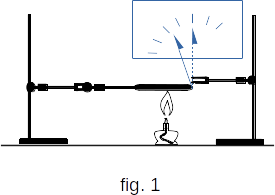From the Thermal expansion of solid and liquid bodies
57. Thermal expansion
When the body temperature changes, its size changes. However, the increase in size, for example, a small metal rod is so small that it is even hard to notice. In order to see the expansion visible, you can use a long arrow with its axis at one end of the rod (fig. 1). Then, with a small shift of the rod end, the arrow will turn a small angle, but its long end will move along the scale at a fairly large distance.

The longer the rod, the larger its size increases when heated, as the temperature rises the length of each section of the rod increases.
The extension of bodies when heated is taken into account in the technique. For example, the railway rails are not placed close to each other, but leave small spaces between them. Thanks to the gaps between the rails, the rails do not deform during warm weather.
Rods made of different materials expand differently when heated. As a result, the plate, riveted from two different metals ( for example copper and iron), bends when heated. This can be explained in this way. When it is free, the copper plate would extend longer than the iron plate. But the plates are bundled together. Therefore, there is a bend, and the copper plate is less extended, while the iron plate, on the contrary, is more extended. The iron plate would be stretched by the forces arising from heating, while the copper plate would be compressed.
These kinds of internal tensions always occur in solid bodies, bound together, expanding differently when heated, as well as when a homogeneous body is heated unevenly. For example, a glass bottle or cup may burst if hot water is poured into it. The forces generated by expansion caused by heating or compression caused by cooling are very high. Dissimilar materials that are subject to periodic heating and cooling should only be joined together when their dimensions change equally as the temperature changes. This is particularly important when the product is large. For example, iron and concrete expand equally when heated. That is why reinforced concrete is widely used, hardened concrete mortar poured into an iron grid. If concrete and iron expanded differently, as a result of daily and annual temperature fluctuations, the reinforced concrete structure would soon be destroyed.
When the temperature changes, not only the length changes, but all other linear body dimensions as well. So, at a round rod diameter increases at heating as much as the length of a rod increases. At the plate in the same number of times increases the length, width and thickness.
If a plate with a round hole is heated, the diameter of the hole will also increase. The matter is that at uniform heating in a body there are no forces of elasticity. Therefore, the expansion occurs as if the plate was solid.
This can be seen from experiments with a metal ball that passes through a metal ring with almost no gap. The ball gets stuck in the ring if it is heated and passes with a large gap if the ring is heated. Conversely, when the ring is cooled, the ball gets stuck, and cooling the ball increases the gap between it and the ring.